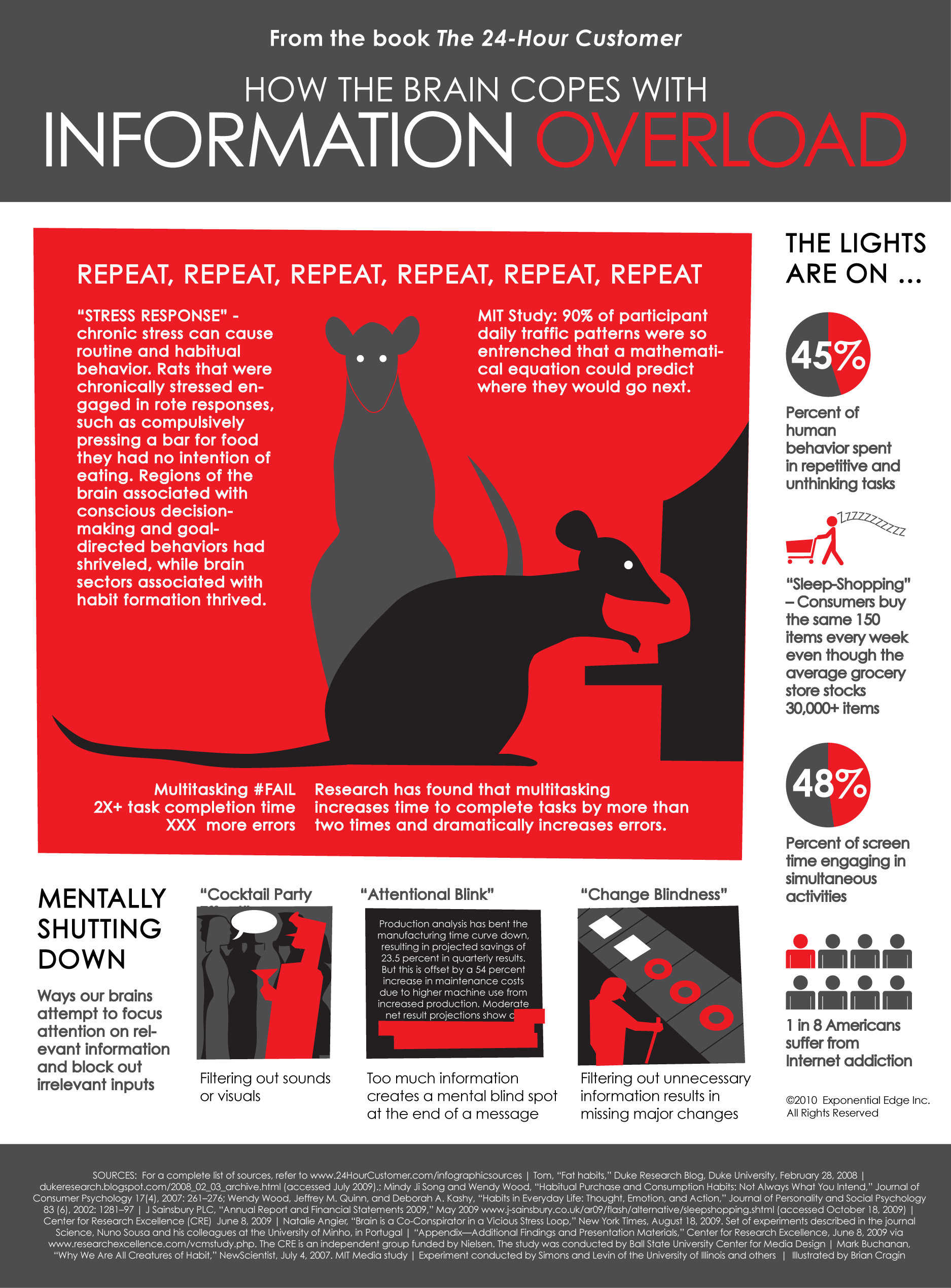In a prior infographic, I explored the explosion of data and product proliferation and how this increases pressure on our attention (bound by 16 waking hours a day). This attention bottleneck helps to explain why we often feel so overwhelmed. But how does the brain actually cope with information overload? Are there patterns to our behavior?
One set of studies revealed that chronic stress leads to habitual and repetitive behaviors. Nuno Sousa and his colleagues at the University of Minho in Portugal, found that rats that were chronically stressed engaged in rote responses, such as compulsively pressing a bar for food they had no intention of eating. Researchers discovered that the regions of the brain associated with conscious decision-making and goal-directed behaviors had shriveled, while brain sectors associated with habit-formation thrived.
Entrenched Traffic Patterns
Another study led by Professor Sandy Pentland at MIT's Media Lab, equipped people with mobile devices to track their location around the Boston area and found that the daily traffic patterns of participants were so entrenched that a computer algorithm could predict for almost 90% of participants where they would go next. As location-based technology becomes mainstream, data from companies such as Foursquare, Gowalla, Twitter, and Facebook Places will add to this body of research providing further insight on human daily routines.
Do you Sleep-Shop?
J. Sainsbury, a major grocer in the U.K. found that even though the average grocery store stocks 30,000+ SKUs, most shoppers tend to buy the same 150 items every week. Walk into any grocery store and you will see shoppers preoccupied with cell phones in their ear automatically tossing pasta from the shelf into their cart.
People cope in other ways by mentally filtering out information by seeking only what's new and different. This has been found in psychological studies such as "The Cocktail Party" effect and sometimes results in "Change Blindness" where new things get overlooked. These filters help to explain why bright shiny things tend to attract us but other things that appear routine quickly become classified as background noise.
Routines and Habits Create Competitive Advantage
What all of this means is when people are trying to finish what they have on their plate, new menu items fall off the radar. Customers tend to remain with the status quo unless there is a trigger that prompts them to wake-up and change their pattern of behavior. Inertia can work in the favor of an incumbent provider especially when there is effort and time involved to switch. Customer inertia creates competitive advantage and is another hidden but powerful force of Time-onomics.
We have seen evidence of this trend in the rise of the Inattention Economy where people purposefully reduce the demands on their attention by automating and outsourcing tasks such as signing up for auto bill pay services. A banker that attended one of my recent keynotes described this to me as, "The Magic 7." Once a customer signs up for seven bank services (such as credit card, direct deposit, bill pay, and mobile alerts) they will have the customer for life.
New market entrants seeking to acquire customers should market around triggers such as personal or life events, peers, or physical needs when customers are most receptive to alternatives. Even still, if you're trying to win customers from existing alternatives you will have to provide breakthrough value, not just incremental value. Making the transition frictionless and easy as possible will also play a big role in increasing customer adoption of a new product or service.
Library Journal says Adrian Ott is, "revolutionizing marketing by adding the concept of time." She is author of the new book The 24-Hour Customer: New Rules for Winning in a Time-Starved, Always-Connected Economy and CEO of Exponential Edge® Inc. consulting. Follow Adrian on Twitter at @ExponentialEdge
©2010 Exponential Edge Inc., All Rights Reserved
Monday, 1 November 2010
How the Brain Reacts When We Have Much to Do [Infographic] | Fast Company
via fastcompany.com
